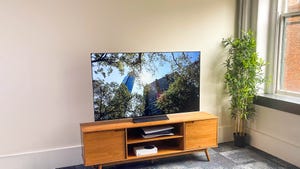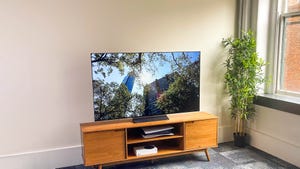
Best TV for PS5 and Xbox Series X, Series S for 2023: LG OLED, Samsung QLED, Vizio - CNET
It’s no secret that all TVs aren’t created equal, especially when it comes to gaming. While any TV with an HDMI port will be compatible with a PS5, Xbox Series X and Xbox Series S console, if your TV isn’t up to snuff, it may be unable to take advantage of these consoles’ best features.
The best 4K TVs these days are equipped with HDMI 2.1 ports, which have the power to let you play at 4K with HDR and reach frame rates as high as 120 frames per second. On top of all that, the gameplay stays butter-smooth, with the consoles and TV playing nice via variable refresh rate (VRR), which reduces choppy movement and screen tearing.
The good news is that you don’t have to spend a fortune on an 88-inch 8K behemoth to get these gaming console-friendly features. In fact, you can find most of the features necessary for an excellent gaming experience, including 4K 120Hz and VRR, in 50-inch TVs at $600 or less and 65-inch models for less than $1,000.
Best TVs for PS5 and Xbox
Here are our current favorite gaming TV options. Unless otherwise noted all of the prices listed are for 65-inch sizes, but every series is available in other sizes, too.
David Katzmaier/CNET
LG’s C2 offers some of the best TV image quality we’ve tested, comes in a variety of sizes and includes the full range of gaming features on every input. We also like this 4K TV’s specialized Game Optimizer settings suite. It’s a great choice for gamers who want an excellent picture and aren’t afraid to splurge to get it.
David Katzmaier/CNET
If OLED isn’t your thing, Samsung’s QN90B offers the best non-OLED picture quality we’ve ever seen. Image quality is incredibly bright, with minimal blooming from the local dimming backlight. This gaming TV option also has a new gaming hub that features Xbox cloud gaming built-in as well as a range of game-friendly adjustments and modes.
David Katzmaier/CNET
Sizes
55-, 65-, 75- 85-inch
TV Technology
QLED with Mini-LED
Smart TV
Yes (Roku TV)
Resolution
4K
HDMI Ports
4
Our favorite TV overall for the money happens to be an excellent gaming TV as well. This TCL supports all the high-end gaming extras you expect, including 4K, 120Hz input and variable refresh rate. Our tests of its gaming picture revealed excellent overall quality, in particular shadow detail.
David Katzmaier/CNET
Sizes
55-, 65-, 75-inch
TV Technology
Mini-LED with local dimming
Smart TV
Yes (Google TV)
Resolution
4K
HDMI Ports
4
In our review of the Hisense we rated its overall image quality nearly as good as the TCL, and we actually liked its gaming picture a bit better, thanks to punchier highlights. It comes in second to the TCL with worse lag, but most people won’t notice the extra 5 milliseconds. Gamers can’t go wrong with either one.
David Katzmaier
The Vizio V-Series costs hundreds less than any of the TVs above, its image quality can’t compete, and it lacks 4K, 120Hz input, but for a budget model its gaming chops are top-notch. It’s the only budget TV we’ve seen that supports variable refresh rate, and its overall image quality was a cut above similarly priced models from TCL, Hisense and others.
The price shown below is for the 50-inch size.
David Katzmaier/CNET
Sizes
50-, 65-, 75-inch
TV Technology
LED with local dimming
Smart TV
Yes (SmartCast)
Resolution
4K
HDMI Ports
4
With a price generally lower than any of the TVs above, this Vizio’s image quality and gaming features aren’t quite as good, but it’s still a solid step above budget gaming TVs. Local dimming achieves solid contrast and the MQX has both 4K/120Hz input capability and VRR, which are rare at this price.
Gaming TV FAQs
Below you’ll find answers to some of the most common questions about the best gaming TVs, followed by the charts that show which features are available on which TVs.
What TVs support HDMI 2.1 features?
All the advanced gaming features we’ve mentioned– 120Hz input and VRR, as well as the more common Auto Low Latency Mode, aka Auto Game Mode, and eARC — are roughly grouped under the HDMI 2.1 standard, but not all of the TVs in the charts below include every feature, nor deliver the full video and audio bandwidth that’s possible with HDMI 2.1.
Even more confusing, input capability can vary on the same TV. Behind the physical connection where you plug an HDMI cable is a subsection of the TV’s processing, namely a chip. These chips cost money, like everything else. In order to keep costs down, not every input on the TV is fully capable of all the latest features and frame rates. To put it another way, every road on Earth could be capable of highway speeds, but building them all that way would be expensive and rather pointless.
For example, one HDMI input might be capable of eARC, but not be able to handle 4K at 120Hz. Just something to keep in mind as you peruse the charts below. Also, there are some important brand and model specifics that didn’t fit in the chart; please check the bullet points below for details.
What is 120Hz input?
Despite TVs being capable of 120Hz refresh for well over a decade, the ability to input 120Hz is a far more recent development. This is largely due to the fact that other than a fairly beefy gaming PC, there just haven’t been any 120Hz sources. That all changes with the PS5 and Series X. Some of the TVs on our list can accept 4K at 120Hz on all HDMI inputs. Others can only do so on select inputs and one, the TCL 6-Series, can only accept 120Hz at lower-than-4K resolution (1440p).
The Xbox Series S can also output 4K at 120Hz, but internally the game is rendered at a lower resolution (1440p) and upscaled before it’s sent to your TV.
For more info, check out the truth about 4K TV refresh rates — and beware fake 120Hz refresh rates on 4K TVs.
What is VRR?
VRR, or variable refresh rate, is a new TV feature that you’d probably be surprised wasn’t already a thing. All modern TVs have a fixed refresh rate. A 60Hz TV is going to refresh, or create, a new image 60 times a second. The problem is a new console might not be ready to send a new image.
Let’s say you’re in the middle of a huge boss battle, with lots of enemies and explosions. The console struggles to render everything in the allotted time. The TV still needs something so the console might send a duplicate of the previous image, creating juddering on screen, or it might send a partially new image, resulting in the image looking like someone tore a page off the top and revealed the new page below.
VRR gives the TV some flexibility to wait for the new frame from the console. This will result in better gaming performance with smoother action and less tearing.
What is ALLM or Game mode?
Game mode turns off most of the image-enhancing features of the TV, reducing input lag. We’ll discuss input lag below, but the specific feature to look for is called either Auto Low Latency Mode or Auto Game Mode. Different manufacturers call it one or the other, but the basic idea is the same. Sensing a signal from the console, the TV switches on game mode automatically. This means you don’t need to find your TV’s remote to enable game mode. Not a huge deal, but convenient. All the TVs listed above have, or will have, one or the other.
What about input lag?
Input lag describes how long in milliseconds it takes for the TV to create an image. If this is too high, there’s a delay between when you press a button on the controller and when that action appears on screen. In many games, like shooters or platformers, timing is crucial and a TV with high input lag could hurt your performance.
As a longtime console gamer myself, I can easily notice the difference between high (greater than 100ms) and low input lag (sub-30ms). The good news is, most modern TVs have input lag that’s low enough that most people won’t notice it. Largely gone are the days of 100-plus-millisecond input lags… at least when you enable game mode.
So as long as the TV has a game mode, you’re probably fine, though it’s worth checking CNET’s reviews for the exact numbers to see if it has low input lag. Lower, in this case, is always better.
What is eARC?
While not a console feature, eARC is a next-gen TV feature to keep in mind. It’s the evolution of ARC, or Audio Return Channel. This sends audio from a TV’s internal apps (such as Netflix or Vudu), back down the HDMI cable to a receiver or soundbar. With eARC, newer formats like Dolby Atmos can be transmitted as well.
The issue is in many cases, eARC often precludes higher resolutions or frame rates on the same input. So if you’ve connected your PS5 to your receiver and the receiver to the TV, you can have eARC audio back from the TV or 4K120, but usually not both. This is only important if you plan on using the internal apps in a TV (as in, not a Roku or Amazon streaming stick) and you want to use the new audio formats via eARC.
As well as covering TV and other display tech, Geoff does photo tours of cool museums and locations around the world, including nuclear submarines, massive aircraft carriers, medieval castles, airplane graveyards and more.
You can follow his exploits on Instagram and YouTube, and on his travel blog, BaldNomad. He also wrote a bestselling sci-fi novel about city-size submarines, along with a sequel.




